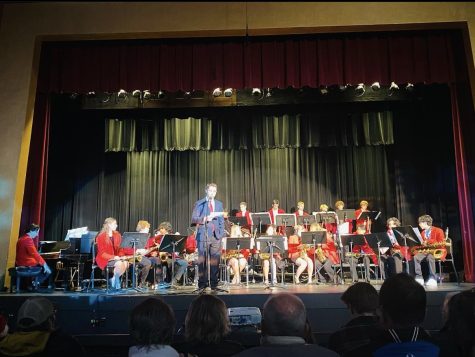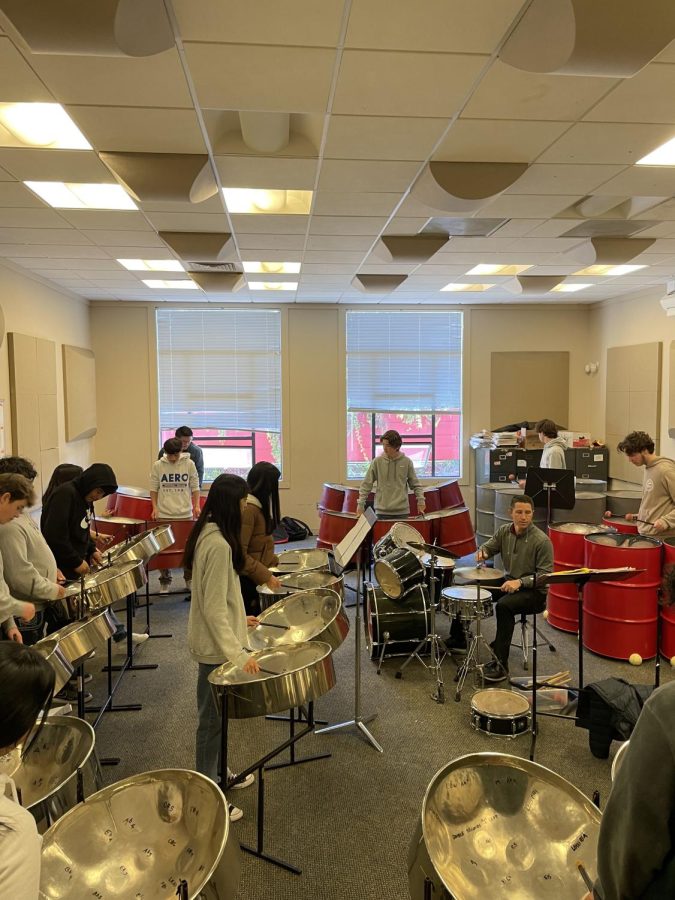Freshmen Need Bigger Brains: Why Music Class Should be Required for 9th Graders
December 9, 2022
“When playing music, the brain actually grows in certain areas – the corpus callosum is bigger in musicians than in non-musicians,” says Mr. Burdick, the band director at San Rafael High School. “[The corpus callosum] is the part that connects both parts of the brain, and it makes them work together better. You can switch tasks a little more quickly, and you’re able to draw on different parts of your experience to better solve problems.”
Brain growth is just one of many social, emotional, and mental health benefits derived from creating or producing music. At SR, students have unique opportunities to become involved in excellent music classes, but few students choose to. It could be out of fear of learning something new, or simply ignorance of these opportunities, but the music classes struggle to recruit freshmen every year while visual arts classes are too full for any freshmen to even get in.
To introduce students to the opportunities of music classes, I propose that all freshmen be required to enroll in a music class through their first year of high school.
“Particularly with music, I generally find that it takes about a full year before kids are starting to get it,” says Burdick.
You might think that just listening to your rap or classical music is enough to reap these benefits. Maybe your parents played you Baby Beethoven and now you believe that you’re set for life. Listening to music has its health benefits, but it’s nothing compared to the effects of making it yourself.
In a University of Pennsylvania Medicine News Blog, John Dani, PhD, described playing an instrument as “one of the best ways to keep the brain healthy,” and “a total ‘workout’ for the brain.”
These benefits apply no matter the age group. In young kids, producing music can improve and enhance language development and visualization of spatial information, while in older adults, music can slow memory loss and other effects of aging.
Music has been proven to make young people better at managing their anxiety, as well as boost their self-confidence and self-esteem. During high school, (especially for our post-Covid freshmen) anxiety, self-esteem, and other related stresses are usually at their peak. At the same time, students are being challenged academically at a new level, experiencing the higher intensity of a high school curriculum.
Learning and producing music can help with all of that.
San Rafael senior and piano student Stephanie Garcia Valencia says, “I actually listen to music while studying, I will put on a song and then start going over flashcards. So the day of the test, I will start singing the song in my head and I’ve always retained enough info to get me through the exam.”
SR Sophomore and Steel Pans student Anthony Tajbakhsh says, “[Steel Pans] relaxes me and also gives me a little bit of energy.” This is why he enjoys having the class early in the morning.
To me, these benefits are not distant statistics and quotes. I’ve played music for more than nine years, and been a member of Jazz Band at SR throughout high school. While learning improvisation on my tenor saxophone in these past couple years, I’ve noticed how these skills of thinking on the spot have translated into coming up with sentences in Spanish. In the same way I was learning the 12 bar blues freshman year, I was learning simple conjugations in Spanish. Now, with the structure in place, I can navigate complex chord progressions, and carry a conversation in a second language.
And no matter how many times I use it, I still have to sing the song I learned in 9th grade to remember the quadratic formula, but I’ve never forgotten it.
Currently, music classes are not required at SR. In place of that, there is a Fine Arts requirement, for which students have to take 2 years of a “Fine Art” to graduate. However, Fine Arts includes both Visual (Drawing, Ceramics, Photography) and Performing Arts (All music classes, Theater). When given the choice, most students opt for visual arts.
Priority in Visual Arts classes is given to juniors and seniors, so some students wait two or three years to get into a class, only to find out they don’t actually like visual art. “I would rather have started music freshman year,” says one senior (who wished to remain anonymous) struggling in their visual art class.
SR can’t guarantee a full course load to incoming freshmen, unless that 7th class is music. Freshmen might inadvertently have an extra-stressful junior year because they put off fulfilling their fine arts requirement when their academic load is lighter. Alternatively, they could fulfill that requirement early by taking a music class their first year, helping them learn how to manage their stress and solve problems along the way.
SR is overflowing with opportunities in music classes. The music program offers advanced Jazz and Wind Ensembles, beginning guitar and piano classes, beginning and advanced Steel Pans classes, and a brand new digital music composition class housed in the new STEAM building.
“I think it’s awesome that we have opportunities for beginners who want to perform, and those who don’t,” says Burdick. In classes like guitar, piano or music tech, students don’t have to perform. But in Jazz Ensemble, Wind Ensemble, choir, and Steel Pans, students can explore their on-stage persona.
Digital music composition allows students to explore music production, using software like BandLab and Logic to create their own music with their own sound.
“It’s not magic. Creating music, you’re making simple choices based on your background and the music you like,” says Gordon.
Digital music provides opportunities for musical beginners to explore composition in a low-pressure environment, while also allowing more advanced students to explore the full scope of modern music.
“It’s different from other music classes in the sense that you don’t need to play an instrument to still be able to make music, thus making music more accessible,” says senior Dylan Moayedi, a digital music and orchestra student.
These array of opportunities are led by excellent teachers like Mr. Burdick, Mr. Gordon, and Ms. Lerner-Wright, well-funded by SR’s powerful Music Boosters group, and supported by the administration; so why are only 270 students out of a school of 1,300 involved in music?
Freshmen need to know that these opportunities are available to them, and need to know the benefits. How many students could do better academically, mentally, emotionally, or even socially if they were exposed to the music environment early in high school?
Kendra Chung, another senior in Jazz Band, speaks highly of the power of the music program in making friendships. “It’s an outlet for a lot of people, and you make so many friends in your music classes and you build relationships with them over the years. They become your lifelong friends.”
If freshmen were required to learn music, and be made aware of its lifelong benefits, they would fare better in high school by any number of metrics. And they might even come out the other side with the big brains they need to succeed.







































